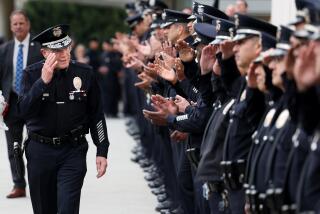LAPD often deploys fewer patrol officers than needed, review finds
The number of police officers patrolling some of Los Angeles’ most crime-ridden areas routinely falls short of the Police Department’s staffing needs, according to an internal report reviewed by The Times.
The confidential report on the five stations in LAPD’s Central Bureau, which includes the Rampart, Hollenbeck and Newton divisions, found there were often fewer officers patrolling streets than the number called for by the department’s computer-generated deployment plan.
Rampart Division, for example, failed to meet its staffing goal every day of the month-long period that was analyzed, according to the report.
The patrol levels are set to ensure that officers can meet the department’s requirement that they respond to emergency calls within seven minutes. Department officials told The Times they did not have statistics on the divisions’ response times immediately available.
The station with the strongest patrol record was Northeast Division, which appeared to deploy the targeted number of officers 90% of the time. The department review, however, found its staffing levels were skewed many days by the use of so-called ghost cars — a scheme in which officers are shown to be in the field when they are actually behind a desk or working non-patrol duty.
The report’s findings contradicted claims LAPD Assistant Chief Earl Paysinger made last week when he told the civilian Police Commission the inquiry had turned up no sign that officers or their commanders were manipulating deployment statistics. The department launched its inquiry after the commission’s inspector general presented LAPD brass with evidence indicating that divisions were using ghost cars to pad deployment figures.
Details from the LAPD’s report mark the latest twist in an increasingly contentious debate over the accuracy of the department’s deployment statistics and broader concerns about whether the department’s heavy reliance on data to judge performance has led division commanders to seek out ways to distort statistics in a favorable light.
Department officials analyzed records of patrol deployments in the five divisions from April and found that each division, except Northeast, missed the mark more than a third of the time. Along with Rampart’s complete failure, Newton Division reached the target on only five days during the month, Hollenbeck Division on 10 days and Central Division on 19 days, according to the report.
In an interview, Paysinger downplayed the importance of the deployment levels set by the department’s computer program, calling them “merely recommendations” for the captains who run divisions.
He added that divisions were able to operate adequately at levels below the number recommended by the computer system and that doing so had not compromised public safety. If the number of calls for help to a division surges during a shift, Paysinger said, station supervisors can move officers from other assignments onto patrol duties.
Violent crime in the Central Bureau is up nearly 10% so far this year compared with the same period last year, outpacing the city’s overall rise. And property crimes in the bureau are up a fraction of a percent, despite being down in the rest of the city. LAPD officials have said that the number of officers on patrol does not necessarily translate into higher or lower crime rates.
Northeast Division stood out in the report. Deployment records indicated a high compliance with the staffing goals, but the department’s examination found evidence the division’s statistics were inaccurate.
Nearly every day in which Northeast Division appeared to meet the staffing levels, department investigators also found examples of ghost cars.
On April 4, for instance, Northeast records showed it had met the computer-generated goal of deploying 17 patrol cars over the course of the day, according to the report. The officer or officers assigned to one of those cars, however, spent the shift assisting detectives instead of answering radio calls and driving the streets looking for problems. Another car in a later shift was used as “a shuttle,” the report found.
In all, the practice was used on 24 of the 27 days that Northeast met its patrol target. Ghost cars also occurred in Hollenbeck Division, but less frequently, the report found. The report documented numerous days in several of the divisions in which officers and supervisors failed to submit required work logs, making it difficult or impossible to determine whether officers were on patrol.
The report did not make clear whether the use of ghost cars allowed Northeast to reach the recommended patrol numbers.
Based on the “potential manipulation” of deployment numbers uncovered, Paysinger ordered an internal investigation to determine whether anyone violated department policies, the report concluded. That investigation remains open.
In his interview with The Times on Monday, Paysinger sought to “clarify” public comments he made last week to the Police Commission, which oversees the department. At a meeting to discuss the inspector general’s findings on the ghost car issue, Paysinger assured the board twice that the inquiry had found no signs of problems. “The inspection I commissioned didn’t reveal any deceptive practices, troublesome deployment patterns, any inconsistencies,” he said.
In fact, some “troubling patterns” were uncovered, Paysinger acknowledged to The Times.
If captains or others in their chain of command are intentionally misconstruing the number of officers on patrol, Paysinger speculated that it was because they are “competitive people who want to do well.”
At the commission meeting last week, LAPD Chief Charlie Beck defended the department’s use of deployment statistics, crime statistics and other data to benchmark whether a division is performing to expectations, saying they were valuable tools. The chief acknowledged, however, that captains and others in their command staff might feel there is an incentive “to meet the goals placed on them by their boss.”
“There is a lot of pressure on the commands.... Pressure is part of this business,” Beck told reporters after the meeting. “The department has high expectations and those expectations come from what is placed on us by the public. But we need to make sure our commands have the ability to meet that.”
Twitter: @JoelRubin
Times staff writer Ben Poston contributed to this report.
More to Read
Sign up for Essential California
The most important California stories and recommendations in your inbox every morning.
You may occasionally receive promotional content from the Los Angeles Times.











